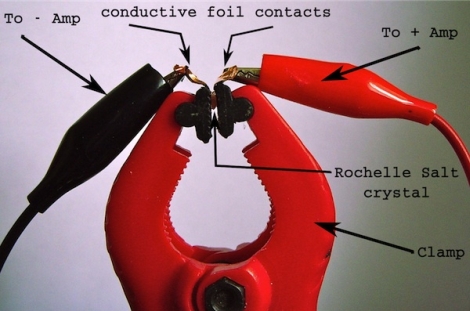
[Leafcutter] is big in to making music and has put together all sorts of musical instruments and tools over the years. Recently, he was inspired to make his own piezo crystals, and wrote in to share the results of his experiments with us.
[Leafcutter] is no stranger to messing around with piezo elements, and after seeing [Collin’s] tutorial on making your own piezo crystals at home, he knew he had to give it a try. He stopped by the grocery store to fetch all of the ingredients, then followed [Collin’s] instructions to the letter…well, almost. It seems that he might have cooled the solution too quickly, so he found himself with a jar full of tiny, barely usable piezo crystals instead of larger ones like [Collin] was able to produce.
Undeterred, he decided to see if the stuff was any good, and rigged up a makeshift contact microphone using some conductive foil and a clamp. He piped the output to his amplifier, and wouldn’t you know it…it worked!
He has a small sound clip of what the mic sounded like on his site, and it worked pretty darn well despite the crystal’s tiny size. He is going to give the whole process another go, so we hope to see more experiments with bigger crystals in the near future.















crystal + foil+amp=microphone?
what kind of magic is this?
It’s piezo magic :)
Piezoelectricity is the property of certain substances (piezoelectric crystals) to turn applied physical force into electricity, or electricity into physical force. So, making noise will cause this crystal to vibrate, and produce electricity. Hook some wires up to it (oversimplifying a bit), and you have a device that turns sound into electric signals. You can do the inverse, and send a recorded signal to a piezoelectric crystal, and you have a speaker. Much the way that you can plug headphones into your mic jack and use them as a (poor) microphone.
maybe lighter spark giving crystal can work too it relative large
For me it would be cheaper, quicker to drive over to my friends shale pit, and chop some hunks out of the vein of quartz running through it. This is really getting down to old tech, as electronics are concerned.
The small size of the crystal is actually an advantage for this kind of application. A bigger one looks nicer in the pic but doesn’t work so well as a microphone transducer.
This thing is awesome
You might also want to look at carbon mics – based on varying resistance of carbon granules. Still in use in millions of older telephones.
I really like the sound he got out of that. It is unique and I encourage its use in music making.
Rad.
Unreal! I have one of these piezo microphones. Never hear surfaces the same way again.
Can even record results in an audio editor like GoldWave and torture them all to my will? Definitely yes.
For being totally blind since birth, microphones and speakers have intrigued me, but these contact microphones have “opened my eyes” in more ways than one!
I love this thing!
I like to put this next to a motor and hear it actually vev up or throttle down! Gives new meaning to “drive”.